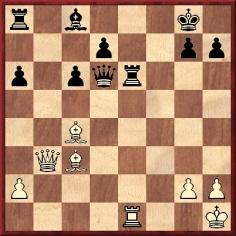
Edward Winter
Following on from our feature article Adams v Torre – A Sham?, João Pedro S. Mendonça Correia (Lisbon) refers to another position leading to the back-rank theme. It comes from a game played in the first half of the 1880s in which Siegbert Tarrasch was White against Bernhard Richter:

After 1...Kh8 (given a question mark by Tarrasch) White won with 2 Bxe6 dxe6 3 Rd1 Qc7
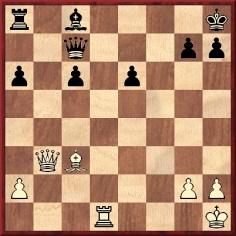
4 Ba5 Qxa5 5 Qb4 Resigns.
Source: Dreihundert Schachpartien by S. Tarrasch (Leipzig, 1909), page 43. See also page 37 of the English edition Three Hundred Chess Games (Park Hill, 1999). The position appeared too on pages 262-263 of Tarrasch’s book Das Schachspiel (Berlin, 1931) and pages 186-187 of The Game of Chess (London, 1935).
It may be recalled from page 29 of Chess Explorations that C.N. 53 gave, with the winner’s notes, the game below:
Lorenzo Ponce-Sala – J. Parpal
Barcelona, 1950
Sicilian Defence
1 e4 c5 2 Nf3 d6 3 d4 cxd4 4 Nxd4 Nf6 5 Nc3 g6 6 Be2 Nc6 7 Be3 Bg7 8 f4 Qb6 9 Nf5 Qxb2 10 Nxg7+ Kf8 11 Bd2 Kxg7 12 Rb1 Qa3 13 O-O Nd4 14 e5 Nxe2+ 15 Qxe2 dxe5 16 fxe5 Qc5+ 17 Be3 Qxc3 18 exf6+ exf6 19 Rb3 Qe5 20 Qd2 Bf5 21 Bh6+ Kg8 22 Re1 Qc5+ 23 Kh1 Qxc2
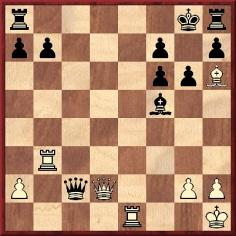
24 Rbe3 Qc6 25 Qd5 Be6 26 Qd4 Bd7
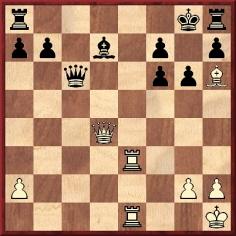
27 Re6 fxe6 28 Qxf6 Resigns.
Source: Estrategia y Táctica en Ajedrez by L. Ponce-Sala (Barcelona, 1975), pages 95-96.
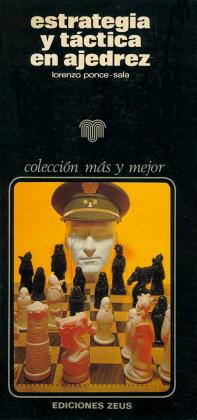
(5817)
From Chess Jottings:
J.R. Capablanca-J. Grommer, New York, 2 July 1913
White exploited his opponent’s back-rank weakness by 39 Re8 Rf4 40 Qb8 Kg8 41 Qb3+ Kh8 42 Rxf8+ Rxf8 43 Qf7 Qc8 44 Qxf8+ Resigns.
A neglected game with clever exploitation of the opponent’s back-rank weakness:
William Albert Fairhurst – Alfred Claude Ivimy (?)
Occasion?
Irregular Opening
1 Nf3 Nf6 2 b4 e6 3 a3 d5 4 Bb2 Bd6 5 e3 b6 6 d4 Nbd7 7 Bb5 O-O 8 Bc6 Rb8 9 Nbd2 Bb7 10 b5 Re8 11 Ne5 Re7 12 Bxb7 Rxb7 13 Nc6 Qc8 14 Nxe7+ Bxe7 15 Rc1 Qf8 16 a4 Nb8 17 c4 a6 18 O-O axb5 19 axb5 dxc4 20 Nxc4 c5 21 Qf3 Nd5 22 e4 Nc7 23 d5 Nxb5 24 d6 Bd8 25 e5 Ra7 26 Qb3 Qe8
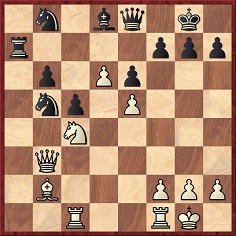
27 d7 Qxd7 28 Rfd1 Nd4 29 Bxd4 cxd4 30 Nxb6 Bxb6
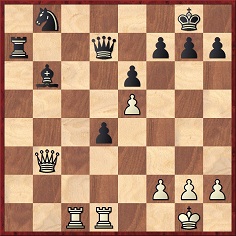
31 Rxd4 Qxd4 32 Qxb6 Resigns.
We are treading gingerly with the particulars of this game. The Chess Amateur, May 1929 (pages 179-180) stated that it was ‘played in March last year in the Manchester v Leeds match’ and gave Black’s name as ‘A.C. Irving’. Since other sources of the time regularly referred to A.C. Ivimy of Leeds, and never to ‘A.C. Irving’, it seems likely that the Chess Amateur mistranscribed his surname.
(2878)
C.N. 3359 presented the following position:
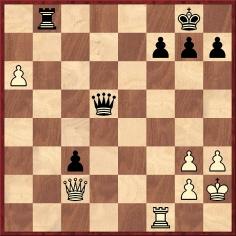
Play went 1...Rb2 2 Rd1 Qa8 3 Qe4 Rb8 4 Rb1 c2 5 Rxb8+ Qxb8 6 a7 Qc8 7 a8(Q) c1(Q) 8 Qe8+ and mate next move.
Our source was page 130 of Taktika Moderního Šachu by L. Pachman (Prague, 1962), which merely had the caption ‘Alapin – H.’. However, we pointed out that the same conclusion had been given on page 365 of the September 1904 issue of the Belgian magazine Revue d’échecs, with the following information: “Fin d’une partie jouée entre un fort joueur de Butler, M. H.A. Stauffer (Blancs) et un amateur de Boston (Noirs)”. The magazine’s source was the Brooklyn Daily Eagle.
(3516)

The conclusion in C.N. 3516 above was 1...Rb2 2 Rd1 Qa8 3 Qe4 Rb8 4 Rb1 c2 5 Rxb8+ Qxb8 6 a7 Qc8 7 a8(Q) c1(Q) 8 Qe8+ and mate next move.
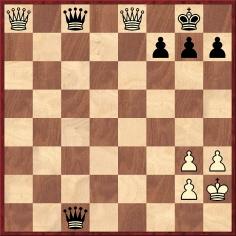
The full game-score remains elusive, but Olimpiu G. Urcan (Singapore) has found the following on page 7 of the 8 May 1904 edition of the Brooklyn Daily Eagle:
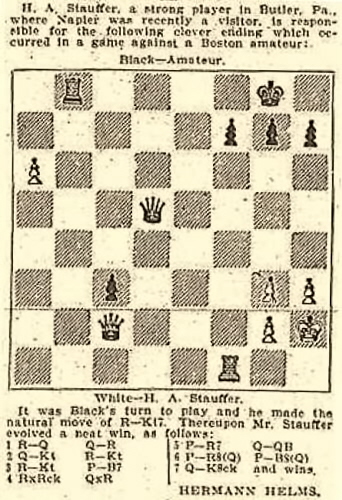
(8338)
What exactly is the corridor mate? At first sight, the question may seem too straightforward to merit much attention, but readers are invited to ponder it briefly before proceeding.
The term was defined on page 46 of the Dictionary of Modern Chess by Byrne J. Horton (New York, 1959) as follows:
‘A mating situation in which the king can move only along the rank at the edge of the board and behind a group of pawns from where he cannot escape when attacked by a rook or queen. The rank along which the king can move serves as a closed “corridor”. The critical area of a “corridor mate” is shown in the accompanying diagram.’

This is in keeping with the presentation of the corridor mate on pages 63-74 of The Art of the Checkmate by Georges Renaud and Victor Kahn (New York, 1953); the original text (‘le mat du Couloir’) appeared on pages 66-77 of L’art de faire mat (Monaco, 1947).
Other sources which have a similar definition include page 92 of the Dictionnaire des échecs by François Le Lionnais and Ernst Maget (Paris, 1967), which gave both ‘mat du corridor’ and ‘mat du couloir’, and page 26 of Le guide des échecs by Nicolas Giffard and Alain Biénabe (Paris, 1993). See also the entries for ‘Korridormatt’ on page 144 of the Grosses Schach-Lexikon by Klaus Lindörfer (Munich, 1991) and for ‘mate del pasillo’ on pages 112-113 of the Diccionario de ajedrez by Antonio Gude (Madrid, 2005). Pages 96-97 of Disney’s Chess Guide by Anatoly Karpov (London, 1997) feature a brief section headed ‘Back Rank’, whereas the equivalent passage in the French version, published in 2000 under the title Le manuel des échecs, is labelled ‘Le mat du couloir’.
From the above-mentioned works it would be concluded that ‘corridor mate’ is merely another name for back-rank mate, but that is far from the end of matters. Chess Thinking by Bruce Pandolfini (New York, 1995) has entries for both ‘back-rank mate’ (page 36) and ‘corridor mate’ (page 78). In the former, Pandolfini wrote:
‘Chessplayers often misuse this term [back-rank mate] for any line-mate by a queen or rook along any edge of the board, whether rank or file. All queen and rook line-mates are corridor mates, but only those given along outside ranks are also back-rank mates.’
The definition of ‘corridor mate’ was given as follows:
‘A line mate by a rook or queen, given along any file or rank when possible escape squares are guarded or obstructed.’
The following definition of ‘back-row mate’ was published on page 71 of Pandolfini’s Chess Complete (New York, 1992):
‘The back-row mate falls into a larger category known as corridor mate, in which either a queen or rook mates by checking along a clear line (rank or file). Corridor mates delivered along an outside row are called back-row mates or back-rank mates, even when the outside mating row is a file.’
Reference to the word ‘file’ means that for Pandolfini a position such as the following ...
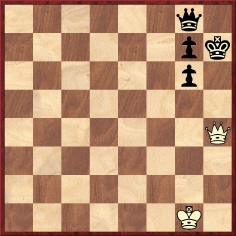
... may be called a back-row mate or a corridor mate. But is that right? And is Pandolfini correct to indicate that a corridor mate could occur even on a central rank or file? According to his explanation the following would be a corridor mate:
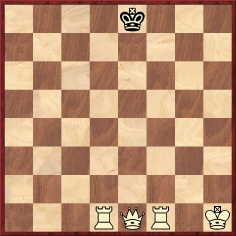
A third possible definition of the corridor mate would be a mate only on a file, and not on a rank, but that has yet to be found in a published source.
Finally, as regards the origins of ‘corridor mate’, how much further back can it be traced, in any language, than 1947, when Renaud and Kahn used ‘mat du couloir’?
(4489)
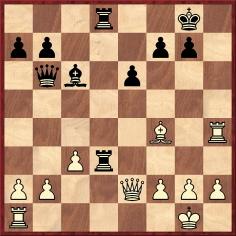
Black to move
The above position was given in William Winter’s Chess for Match Players, i.e. on pages 231-232 of the original 1936 edition and, as shown below, on page 232 of the revised 1951 work:
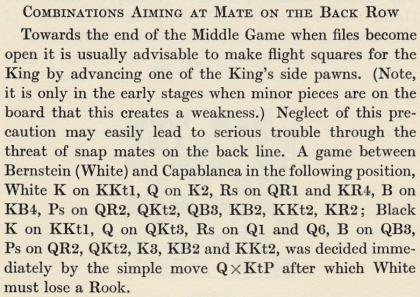
There is an obvious resemblance to the conclusion of Capablanca’s famous victory over Bernstein in Moscow, 1914 (given in My Chess Career), but what is the origin of this version?
(8747)
Michael Schorr (Illingen, Germany) asks for details about this position:
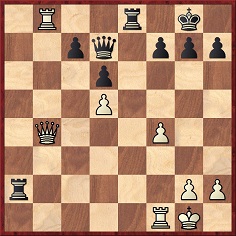
White to move
Our correspondent notes that according to pages 182 and 185 of Erfolgreich kombinieren by Volkhard Igney (Zurich, 2002) the conclusion was 1 Re1 Rd8 2 Qb5 c6 3 Qb6 Rc8 4 dxc6 Rxg2+ 5 Kh1 and wins, whereas pages 27 and 190 of Improve Your Chess Tactics by Yakov Neishtadt (Alkmaar, 2011) had 1 Re1 Rd8 2 Qb5 Rxg2+ 3 Kh1 Resigns; the headings in the books were, respectively, ‘Wehnert-Liess, Saßnitz 1962’ and ‘Wehnert-Leiss, East Germany 1962’.
(9279)
Alan McGowan (Waterloo, Canada) sends an extract from page 304 of the October 1962 Schach, in an article by Kurt Richter:
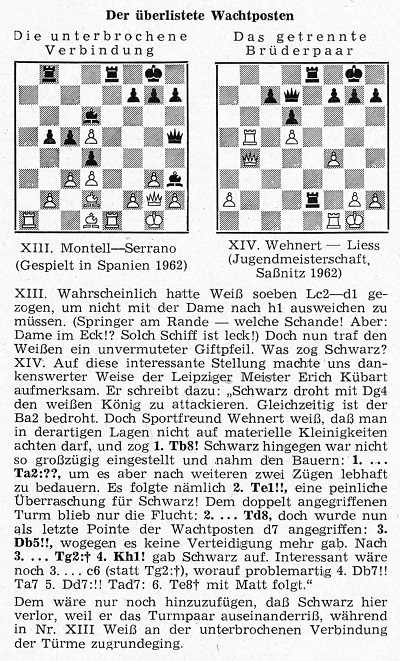
(9286)
To the Archives for other feature articles.
Copyright Edward Winter. All rights reserved.